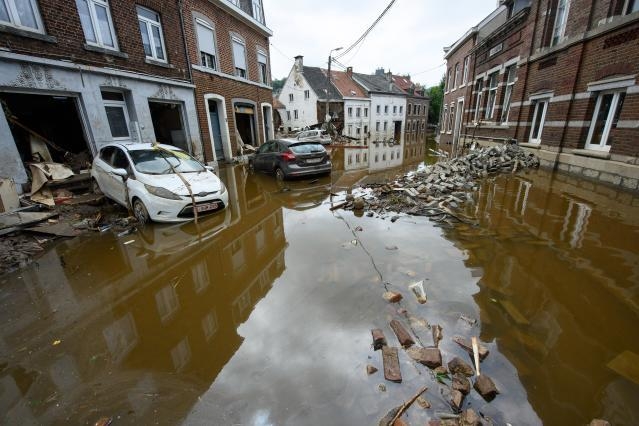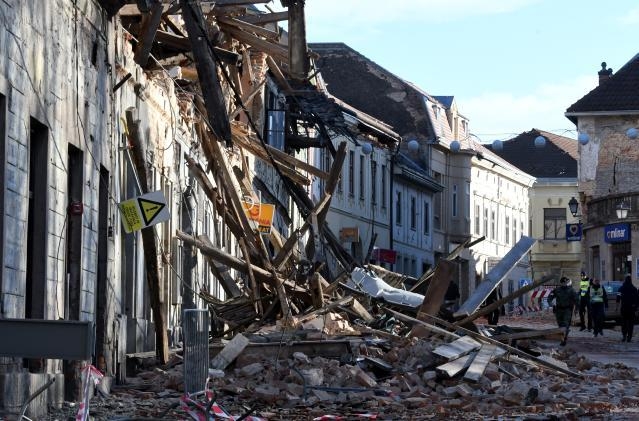EU Solidarity Fund
The European Union Solidarity Fund (EUSF) supports EU Member States and accession countries by offering financial support after severe natural disasters and, since 2020, major health emergencies.

Source: EC - Audiovisual Service

Source: EC - Audiovisual Service
The European Union Solidarity Fund (EUSF) was set up to respond to major natural disasters and express European solidarity to disaster-stricken regions within Europe. The Fund was created as a reaction to the severe floods in Central Europe in the summer of 2002. Since then, it has become one of the main EU instruments for post-disaster recovery and an expression of EU solidarity.
The Fund aims to complement the efforts of EU Member States and accession countries and cover part of their public expenditure. Therefore,
- Only the national authorities of EU Member States and accession countries can seek help from the EUSF.
- Individual citizens, private companies, and organizations within the affected country cannot submit applications.
What type of costs does the EUSF support?
The EUSF only supports public emergency and recovery operations. It only covers non-insurable damage and does not compensate for private losses.
Thresholds and deadline
To be qualified for EUSF support, a country must fulfil the following conditions:
- the extent of the damage must meet the relevant thresholds (as explained below);
- the application must be submitted within 12 weeks of the date of the first damage caused by the disaster. In case of slowly unfolding disasters, such as droughts or health emergencies, this deadline is set at 12 weeks after the first official action is taken against the emergency.
Four types of disasters are eligible for support: major natural disaster, regional natural disaster, natural disaster in a neighbouring state and major health emergency.
- In the event of a major natural disaster, the total direct damage must exceed €3 billion in 2011 prices or 0.6% of the GNI of the affected state, whichever is the lower;
- In the event of smaller, so-called regional natural disaster, the total direct damage must exceed 1.5% of regional GDP (at NUTS2 level). For outermost regions the threshold of 1% of regional GDP is applied;
- In the event that an eligible state is affected by the same major natural disaster as an eligible neighbouring state, there is no threshold;
- In the event of a major health emergency, the total cost for the emergency response measures must exceed € 1.5 billion in 2011 prices, or more than 0.3% of the applicant state’s GNI.
Thresholds for EU Member States and accession countries:
Thresholds for regional disasters – 2025:
If a natural disaster affects multiple regions at NUTS2 level, the threshold will be based on the average GDP of those regions. This calculation considers the share of total damage in each region. The formula to calculate the threshold in this situation:
Read the next section for more guidance.
It is strongly recommended that the body responsible for preparing the application establishes early direct contact with the service in charge in DG Regional and Urban Policy, who can offer advice that will help speed up the application process as much as possible.
Contacts
European Commission
DG Regional and Urban Policy
Unit E1/EUSF team
B-1049 Brussels. Belgium
Functional mailbox, REGIO E1 Solidarity Fund: EC-SOLIDARITY-FUND@ec.europa.eu
Inguna Kramina
Inguna.KRAMINA@ec.europa.eu
phone: +32 229-66062
Petra Varhegyi
Petra.VARHEGYI@ec.europa.eu
phone: +32 229-68248
Application EUSF
Any application has to be received by the Commission within 12 weeks of the date of the first damage caused by the disaster. In case of slowly unfolding disasters, such as droughts or health emergencies, this deadline is set at 12 weeks after the first official action is taken against the emergency.
Below you find the application form, and a guidance for filling out the form.
Questions and answers regarding covid-19 emergency
What can be supported by EUSF?
The eligible operations for the European Union Solidarity Fund (EUSF) are specified in Article 3 of the EUSF regulation. The EUSF supplements Member States' public expenditure for the following essential emergency operations:
Natural disaster
- restoring the working order of infrastructure and plant in the fields of energy, water and waste water, telecommunications, transport, health and education;
- providing temporary accommodation and funding rescue services to meet the needs of the population concerned;
- securing preventive infrastructure and measures of protection of cultural heritage;
- cleaning up disaster-stricken areas, including natural zones, in line with, where appropriate, eco-system based approaches, as well as immediate restoration of affected natural zones to avoid immediate effects from soil erosion.
Health emergencies
- rapidly providing assistance, including medical, to the population affected by a major public health emergency;
- protecting the population from the risk of being affected, including prevention, monitoring or control of the spread of diseases, combating severe risks to public health or mitigating their impact on public health.
The EUSF was not set up with the aim of covering all costs linked to natural disasters. The Fund is limited in principle to non-insurable damage and does not compensate for private losses. Investments in prevention are not eligible.
How much money can you expect?
The methodology for calculating EUSF aid was set out in the 2002-2003 Annual Report on the EUSF and accepted by the European Parliament and the Council. The amount of aid of EUSF for a given disaster is determined based on total direct damage caused by that disaster in relation to the relative wealth of the affected State as reflected by the threshold. The amount of assistance that can be mobilised following a disaster also depends on the budgetary availabilities of the EUSF.
Find the different thresholds in the previous section.
The financial contribution from EUSF must be used within 18 months from the date when the Commission disburses the total aid amount.
Immediate emergency and recovery operations can be financed retroactively starting from the date of first occurrence of damage.
What happens after you sent in the application?
The Commission assesses the application and - if the application is accepted - proposes an amount of aid to the European Parliament and the Council who have to approve it.
Once the appropriations become available in the EU budget, the Commission adopts a decision awarding the aid to the affected state, which receives it immediately and in a single instalment.
Once the aid is paid out, the affected state is responsible for the implementation including the selection of operations and their audit and control. Emergency measures may be financed retroactively from day one of the disaster.
It is worth noting that the EUSF is not a rapid response instrument for dealing with the effects of a natural disaster. Financial aid can only be granted to the applying state following an application and budgetary process which can take several months to complete.
Any change in the bodies listed in the annexes of the EC implementing decision must be promptly communicated to the EC before the end of the implementation phase.
The beneficiary State must submit an implementation report to the Commission within six months after the end of the 18-months implementation period.
The report should include a statement justifying of expenditures, details on other funding sources received (such as insurance settlements and compensation from third parties) for the relevant operations and other supporting documents.
Below is a template for the implementation report, a guidance on the implementation and auditing process and a document with questions and answers on different implementation elements.
Regulations
The regulation for EUSF was set up on 11 November 2002.
The regulation was updated on 15 May 2014. Some of the changes included introducing advance payments, clearer thresholds, and extending the time for submitting applications.
The regulation was updated on 30 March 2020, to include major health emergencies.
Below, you'll find the three different regulations. Additionally, there's a consolidated text which is a document offering an updated and comprehensive version of the legal text. This version incorporates any changes made over time.
- EU Solidarity fund regulation (consolidated text - 2020)
- Regulation (EU) No 461/2020 of the European Parliament and of the Council of 30/03/2020 amending Council regulation (EC) No 2012/2002
- Regulation (EU) No 661/2014 of the European Parliament and of the Council of 15 May 2014 amending Council Regulation (EC) No 2012/2002
- Regulation setting up the EUSF (Regulation (EC) n° 2012/2002 of the Council of 11 November 2002, OJ L 311)
What budget does EUSF have?
Solidarity Fund aid can be mobilised up to a maximum annual total of €500 million (in 2011 prices) plus the unspent allocation from the preceding year which is raised over and above the normal EU budget.
Individual grants must be approved by the European Parliament and the Council following a proposal from the Commission.
One quarter of this amount must remain available on 1 October of every year to meet possible needs through to the end of the year.
In exceptional cases and if the resources remaining for the rest of the year are insufficient, the shortfall may be met out of the next year's budget.
Ex post evaluation report
In May 2019 the Commission published a major evaluation of the work of the EUSF since its creation in 2002 and providing recommendations for the future. The evaluation underlines the high added value of the Fund to support emergency and recovery efforts and to alleviate the financial burden on national and regional authorities. The Fund has provided €5.2 billion, including a record-high €1.2 billion for the 2016/2017 earthquakes in Central Italy.
The report has also identified room for improvement in terms of speed, coherence, effectiveness and public awareness of the interventions.
Articles in Panorama
Panorama is the official magazine of the Directorate-General for Regional and Urban Policy of the European Commission. It serves as a platform to communicate the European Union's regional and urban policies to the general public. Panorama highlights the positive impact of these policies.
Press releases
Find press releases concerning the fund in the Press corner by searching for "EUSF".
Since the European Union Solidarity Fund (EUSF) was created in 2002 until February 2024, it has been used for 110 natural disasters covering a range of different catastrophic events including floods, forest fires, earthquakes, storms, and drought.
The Fund has also been mobilised for 20 interventions as a response to public health emergencies.
24 Member States (plus the UK) and 4 accession countries (Albania, Montenegro, Serbia, and Türkiye) have been supported so far for an amount of over EUR 8.6 billion.
More data on the Solidarity Fund action since 2002 and examples of EUSF interventions is presented in this datastory: EU Solidarity Fund - supporting disaster recovery since 2002 .
Below you find lists of the interventions funded by EUSF, one for natural disasters and another one for health emergencies.
